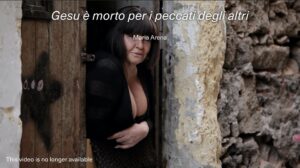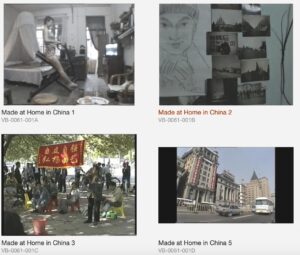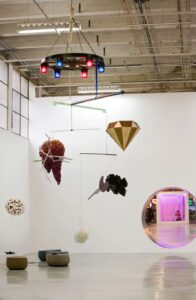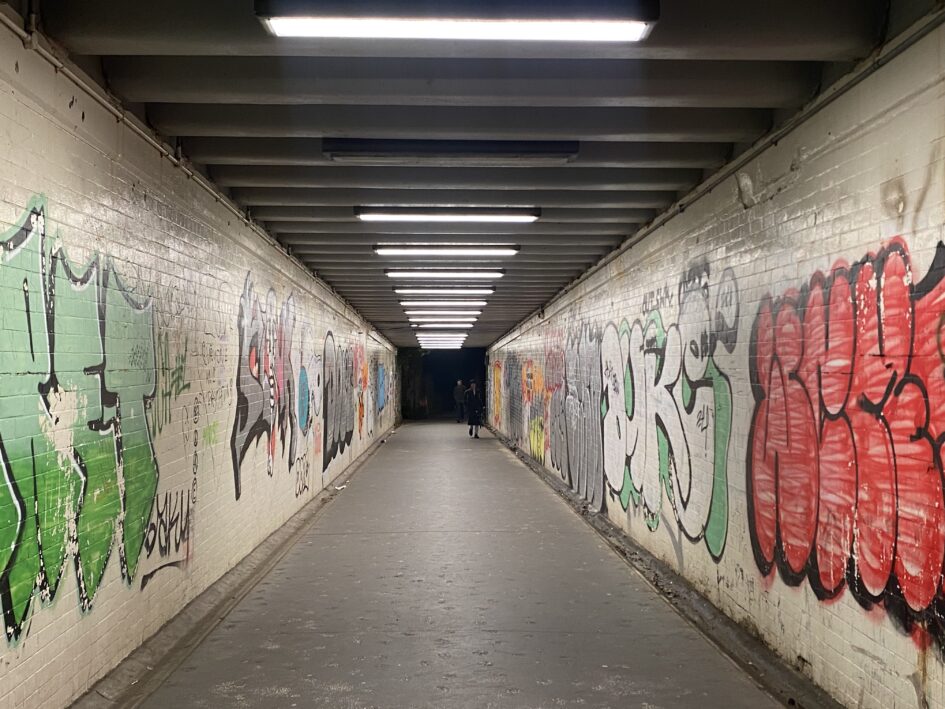Project Title
Echo of Petals in the Dark
Link to previous post: https://blogs.ed.ac.uk/s2676907_curating-2024-2025sem2/2025/02/14/week5-6-the-further-theme-structure-of-telfer-subway-curatorial-project/
Keywords
Ghost Art, Lo-fi Aesthetics, Marginality, Non-Places, Poor Image, Reproducibility, Anti-aesthetic, Site-Specific
Medium
Video, Installation & Sculpture, Print
The use of video in this exhibition directly responds to our Week 8 lecture on Media and Time, particularly the concept of looping as a curatorial strategy. Inspired by Brian Hatton’s observation that looping “dissolves the linearity of causality in time, making video perception spatial rather than sequential,” the project embraces looped projections that allow audiences to enter the narrative at any moment. This non-linear temporal logic aligns with the transient, ghostly aesthetics of the exhibition, and with the nature of the site as a space of passage rather than destination.
Venue
Telfer Subway, Edinburgh
Link to previous post:
- https://blogs.ed.ac.uk/s2676907_curating-2024-2025sem2/2025/01/31/week3:preliminary-curatorial-concept-and-telfer-subway-fieldwork-notes/
- https://blogs.ed.ac.uk/s2676907_curating-2024-2025sem2/2025/02/09/reimagining-non-places-poor-image-curatorial-reflections-on-telfer-subway-site/
Artists / Artworks
• Maria Arena – Gesu è morto per i peccati degli altri (2014)

https://www.e-flux.com/film/652859/gesu-e-morto-per-i-peccati-degli-altri/
This documentary follows trans sex workers in San Berillo, a central red-light district long neglected and now facing removal. Through everyday intimacy and exclusion, it reveals how marginal communities are displaced by urban development—aligning with Ghost Art’s concern for contested visibility in non-places shaped by power and erasure.
• Xu Tan – Peephole(2000)& Made at Home in China (Part 1, 2, 3, 5)(1997-1999)

https://videobureau.org/artist/xu-tan/video/3763?lang=en
This video examines everyday life amid China’s rapid urban transformation in the 1990s. Using a voyeuristic interface, it reflects shifting boundaries between private and public space. The work resonates with Ghost Art by exposing micro-surveillance, bodily reterritorialization, and fragmented visibility under supermodern urban conditions.

https://videobureau.org/artist/xu-tan?lang=en
Shot with a Hi-8 camcorder across Beijing, Shanghai, Guangzhou, and Shenzhen, this lo-fi video captures private spaces amid rapid urban transformation. Juxtaposing domestic interiors and changing cityscapes, it reflects on supermodernity’s impact on everyday life and image-making outside institutional frameworks, aligning with the exhibition’s focus on informal visual resistance.
• Toshio Matsumoto – Shift(1982) Waiting to change (The artist was too famous and has passed away.)

https://youtu.be/aiUdjksGzAE?si=bq3Su3pgmO3cs1cn
This experimental film layers time-delayed architectural zooms into horizontal bands, dissolving linear space and destabilizing visual perception. Through spatial dislocation and sensory fragmentation, it echoes Ghost Art’s engagement with supermodern alienation and glitch-like urban instability.
• Boris Achour – Gyrophare(1997) & Conatus: Bande Annonce(2006)

http://www.galerieallen.com/en/artistes/oeuvres/1093/boris-achour
A police siren enclosed in a plastic bag and hung like discarded matter. This work deflates institutional power into something fragile and banal—blurring the lines between control and informality, authority and trash. It emits a quiet signal of ironic alert from the margins.

https://borisachour.net/conatus-bande-annonce-conatus-trailer-2006-ok-eng/
This kinetic sculpture isolates the form of a police siren, transforming it into a suspended signal of institutional power. As the opening gesture of Achour’s Conatus series, the work detaches symbolic authority from its function—becoming a flickering, ambiguous warning embedded within the echo chamber of Telfer Subway.
• Hannah Black – Bastille(2020)


https://arcadiamissa.com/hannah-black/
A bricked-up structure embedded with torn pages from de Sade’s The 120 Days of Sodom, Bastille echoes the sealed-off stairwell at Telfer Subway. The work constructs a physical and historical blockage, invoking institutional violence, colonial memory, and the recursive production of meaning through language and architecture.
• Elaine Sturtevant – Trilogy of Transgression(2004) Waiting to change (The artist was too famous and has passed away.)

https://www.tate.org.uk/art/artists/elaine-sturtevant-12271
This low-resolution, three-channel video juxtaposes icons of femininity across media—from cartoons to sex objects. Through pixelated fragmentation and provocative feedback loops, Sturtevant critiques gender representation and image control, aligning with the exhibition’s interest in degraded media, mediated bodies, and the circulation of cultural excess.
• Jesse Darling – Come On England, Gorgon (Britannia)(2023)Waiting to change (The artist is too famous)

These twisted steel barricades evoke state infrastructure, bodily containment, and crowd control. Their distorted forms suggest collapse, protest, and fragility within authoritarian systems. The visceral tension between order and rupture mirrors urban flows, inviting viewers into a spatial encounter with institutional breakdown.
• Free City Collective & The Diggers – Free City Publishing(1967–1968)
• The Diggers – The Digger Papers(1968)

https://www.diggers.org/free_city_sheets.htm
https://www.diggers.org/digger_papers_v2.htm
These DIY publications circulated radical ideas outside official channels, serving as vital connectors within 1960s counterculture. Linking local communities through unauthorized distribution, they embody the role of underground media as both political tool and cultural glue—facilitating informal knowledge networks amid institutional exclusion.
When selecting the artists, I tried to keep it realistic. Some well-known artists—although conceptually very fitting—were simply beyond the scale and feasibility of this project. I didn’t want to spend too much time chasing licensing or trying to get big names on board. Instead, I focused on artists whose work resonates with the theme and could be included through archives, permissions, or informal formats. The goal wasn’t prestige—it was to stay site-specific, flexible, and grounded in the spirit of Ghost Art.
Curatorial Statement
Echo of Petals in the Dark – Curatorial Statement
Link to previous post:
- https://blogs.ed.ac.uk/s2676907_curating-2024-2025sem2/2025/01/31/week3:preliminary-curatorial-concept-and-telfer-subway-fieldwork-notes/
- https://blogs.ed.ac.uk/s2676907_curating-2024-2025sem2/2025/02/09/reimagining-non-places-poor-image-curatorial-reflections-on-telfer-subway-site/
- https://blogs.ed.ac.uk/s2676907_curating-2024-2025sem2/2025/02/14/week5-6-the-further-theme-structure-of-telfer-subway-curatorial-project/
- https://blogs.ed.ac.uk/s2676907_curating-2024-2025sem2/2025/03/16/week8-sicp-refinement1%EF%B8%8F⃣-ghost-art-concept-adjustments-case-study/
Schedule
✹ Exhibition Duration
May 1 – May 30, 2025
Daily: 11:00 AM – 7:00 PM
✹ Artist Residency Programmes
1. Poor Image Flash Mob
Artist: Yiran Gu & Peers
Dates: May 3, 10, 17 (early morning activations) Move to June
A lo-fi projection intervention where temporary sculptural forms are flattened into ghost-like digital images cast on the tunnel’s walls and floors. The projections last minutes and vanish—except through their video documentation, forming a digital “ghost archive.”
2. CAP Artist-in-Residence: Non-Place Encounters
Duration: May 6 – 2 Move to June
An emerging artist from the Contemporary Art Practice (CAP) programme engages in open-ended experimentation within the Telfer Subway. Responding to the space as a “non-place,” the residency evolves into gestures, writings, or subtle reconfigurations of the site, developed through process-based making.
3. Sound Residency: Rhythms in Transit
Duration: May 6 – 20 Move to June
A sound artist records performative gestures inside the tunnel—snaps, claps, shuffles—and composes a site-specific soundscape. The resulting audio piece will loop sporadically throughout the tunnel, blending with urban noise to evoke fleeting rhythms of movement and attention.
✹ Public Programme
1. Stroll through Telfer Subway
Dates: May 4 & May 18, 2:00–3:30 PM
A guided walking session inviting audiences to slow down, observe, and converse with the space. Led by the curators and resident artists, the event blends critical reflection with sensory experience, positioning the tunnel not only as an exhibition venue but as a living urban text.
2. Publishing Launch: Telfer Subway Memoirs
Date: May 30
An experimental oral history zine composed of stories collected from residents and tunnel users. Merging personal anecdotes, criminal tales, market scenes, and spatial memory, the memoirs function as a counter-archive of the tunnel, offered freely at the closing event and online.
Accessibility
• Physical Access: Telfer Subway is wheelchair-accessible via ramp.
• Information Access: Wall texts are available in English and Chinese.
• Sensory Access: Selected hours will be designated as Quiet Hours (2–4 PM on weekdays), with minimal noise and projection intensity.
• Neurodiverse Audiences: We offer a downloadable visual guide and sensory-friendly map in advance.
Ethics
The curatorial approach is grounded in non-extractive, place-sensitive methods. No graffiti or traces in the site will be removed or “cleaned” for the sake of exhibition. Public workshops invite rather than impose participation. No artist work is commodified or priced. All artists have consented to temporary reproduction, circulation, and informal formats of display.
Gabi’s online lecture on curatorial ethics really stayed with me—especially her emphasis on relational accountabilityand not taking more than we give. It reminded me that curating isn’t just about organizing things—it’s about how we show up for others, for the site, and for the stories we borrow. In this project, I’ve tried to take that seriously: being careful not to instrumentalize the site, and to treat both people and place with attentiveness and reciprocity.
Timeline
March (Preparation Phase I – Planning & Applications)
• March 1–5: Finalize curatorial concept, keywords, and preliminary artist list
• March 6–10: Draft exhibition proposal and working budget
• March 11–15: Submit funding application to Creative Scotland (Curatorial Micro-Grant)
• March 13–18: Submit site usage request to Edinburgh Council for temporary activation of Telfer Subway
• March 16–20: Contact proposed artists and potential residents; confirm interest and availability
• March 21–25: Coordinate with ECA AV department and external suppliers to pre-book technical equipment (projectors, speakers, sound gear)
• March 26–31: Develop initial communication plan (blog structure, social media channels); design visual identity and poster drafts
April (Preparation Phase II – Logistics & Promotion)
• April 1–3: Finalize curatorial statement, residency formats, and programme outline
• April 4–7: Contact printers for zine and poster production; begin layout design for Telfer Subway Memoirs
• April 8–12: Launch first round of public promotion (blog updates, social media announcement, poster distribution in ECA & surrounding areas)
• April 13–17: Receive technical specs and detailed proposals from participating artists and residents
• April 18–20: Conduct site visit and technical survey; finalize layout for projection and sound installation
• April 21–24: Launch second round of targeted promotion (student networks, community groups, radical publishing circles)
• April 25–30: On-site installation, equipment testing, safety check, signage placement
Timeline Update
I’ve come to realise that being an independent curator means the work rarely follows a neat, linear path—things don’t just happen one after another. Instead, everything overlaps. Planning, communicating with artists, writing, testing install ideas—it all happens at once. So part of this process has been learning to multi-task, to hold multiple timelines and conversations at once without losing focus.
Because of that, I’ve decided to move the artist residency activities and post-exhibition reflection (like editing the zine, archiving, and documentation) into June, after the exhibition wraps. May will stay focused on public-facing events, and June will give us more time and flexibility to reflect, re-enter the tunnel space, and support the artists without rushing.
Budget
Budget Summary
• Artist Fees – £3,000
• Residency Artists – £0 (invited, unpaid)
• Technical & Equipment – £0 (borrowed from ECA BookIt)
• Publications & Print – £800
• Access & Inclusion – £400
• Public Events & Talks – £0
• Promotion & Documentation – £850
• Contingency – £950
Total: £6,000 + £950 contingency = £6,950
(Remaining buffer available: £3,050)
Budget Update
While revisiting my budget, I looked into the artist fee guidelines provided by Creative Scotland and the A–Z Resource for Artist Fees. It made me realise that my original numbers—especially for artist fees and documentation—were quite high in proportion to the overall scale of the project.
Guidance_on_fees_and_day_rates_for_visual_artists_2022
fair-work-rates-of-pay-signposting-guide
So I’ve started cutting down and rebalancing some areas, aiming to make the budget not only more realistic but also more fundable. I want to make sure the funding I apply for aligns with the expectations of small grants, and that every cost feels clearly justified. It’s been a useful exercise in thinking not just as a curator, but also as someone accountable for how resources are distributed.
Funding / Partners and Sponsors
• Primary Funder: University Curatorial Micro-Fund
• Supporting Partner: Edinburgh Ghost Histories Collective (advisory & archival access)
• In-kind Support: ECA AV Department (equipment), Artlink (accessibility guidance), The Diggers Archive (reprint permission)
SICP Overview Before Tutorial 2 © 2025 by Yiran Gu is licensed under CC BY-NC-ND 4.0



3 April 2025 at 16:30
You have a clear and easy-to-navigate approach to your blog, which makes it simple to read and helps you present your ideas effectively. Your trip to Glasgow and the various museums is well documented. My only suggestion is to go into more detail about what it was about those spaces or their curatorial approaches that enhanced your curatorial knowledge. Currently, the focus is more on the spaces themselves rather than your personal growth.
You have done a great job using the blog to document the development of your projects. This showcases your journey and the improvements you have made along the way. One area for improvement would be to integrate curatorial theories into each post by including relevant references.
Remember – For every Blog Post: ask yourself how can I connect this with the 11 weeks of lectures and learning, the themes, and the course resources?
You analyse feedback effectively and incorporate it into your project. Each time you have done this, there have been significant improvements. Remember to keep your project achievable and within budget. Avoid overcomplicating things, and ensure that the artists you choose are realistic options.
One very important consideration we discussed in our planning meetings, which JL emphasized in her presentation, is the need to not just state facts but to explain them as well. For example, how did you arrive at the artist fee total of £3000? This should be based on the Scottish Artist Union guidelines, which you can link to in your submission. Providing this kind of information will demonstrate that you have done your research and found accurate figures.
This approach can be applied to every subheading, such as audience, location, etc. To assist you with this, I have shared a link to JL’s slides below. Please feel free to use these to help improve your blog posts and final submission.
As a final piece of feedback, to enhance future blog posts, refer to JL’s slides presented this week, as they break down some of the subheadings.- https://www.learn.ed.ac.uk/ultra/courses/_117082_1/outline/file/_11117495_1
• A reminder to look at the reading list on Learn for extra resources.
• You must include your independent research and course materials.
• Exhibition research, and the curatorial texts from named exhibitions, are a
key part of this material.